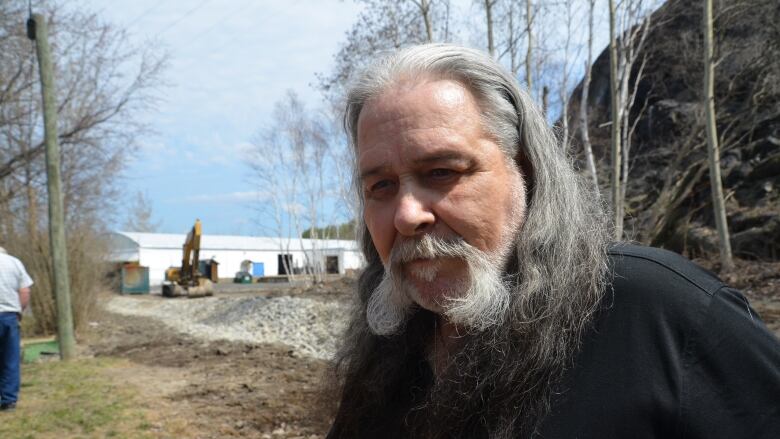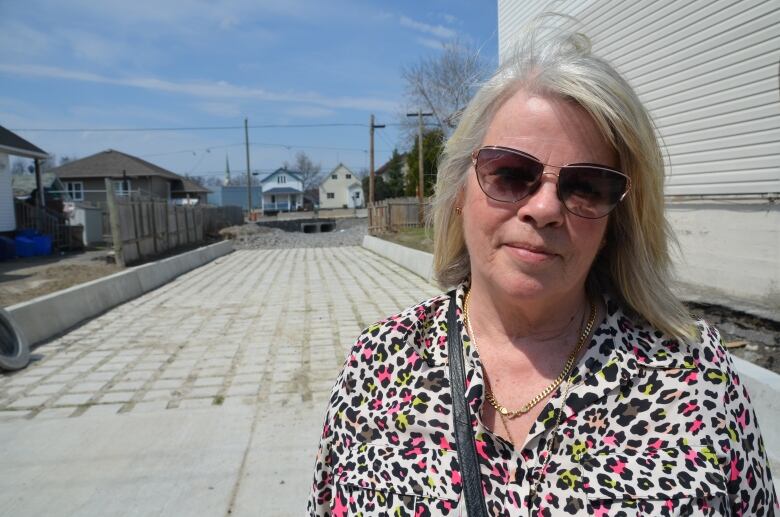$4M Flour Mill flood-proofing underway to end 'nightmare' for Sudbury neighbourhood
Sunrise Ridge developer maintains his hilltop subdivision has not caused flooding

Leo Coutu is happy to have backhoes and construction workers in his backyard.
The 66-year-old says while it may make for a noisy spring and summer this year, he hopes the drainage ditch and the other flood-proofing infrastructure being built in his neighbourhoodwill put an end to the waterfall he says pours into his backyard off Mountain Street.
"Whenever it rains, it gets really loud, and we worry about it coming into the house," says Coutu.
He is one of many people in the Flour Mill who say that water began running down the hill in 2009 when the Sunrise Ridge subdivision was built at the top.
Although Coutu says he's only ever had water in his basement once since the major storm that same year filled the streets with water, as well as flooding other parts of Sudbury, but water running into his backyard is a regular problem.

Two years ago, Sudbury city council committed $4 million to flood proofing the neighbourhood, and now that work is underway.
Three houses and some unused railway tracks were bought, and a drainage channel is being dug to divert water from Mountain Street into Junction Creek.
But city drainage engineer Paul Javor says Sudburiansaren't likely to see it full of water.
"In an ideal world, I suppose it would be dry," says Javor, who adds that walking trails will be built along the drainage channel.
"You always hope you don't get the big events that can cause property damage or affect people negatively, but you do have to be prepared for them."
Phase two of the project will feature another drainage channel running out to the Ponderosa swamp and some sort of structure built on the face of the hill to divert water coming from the top.
Javor says it is still being designed.
"It could be a pipe, it could be a blasted rock channel, it could be encompassing partly a wall, it could be using some natural gullies," he says. "Those are all the parts we're figuring out right now."

"It will look like what it used to look like: dry!" says Ward 12 city councillor Joscelyne Landry-Altmann.
"And not a glacierin the winter time, and when there's a rain storm, this is Niagara Falls. It's been a nightmare for the people that live here."
Mike Challoux is happy, since he can now rent out the basement apartment in his Mountain Streettriplex without the fear of his tenants waking up in a pool of water, but he isn't sure taxpayers should be footing the $4 million bill.
"All this expense, it's the taxpayers taking the burden. Should have been the developer," he says.
The city did consider forcing developer SalDan to pay half, butLandry-Altmann says it's time to move past that debate.
"What's really important is that this gets corrected," she says.
"If it enables the developer to continue developing up on the hill without harming the residents that live down here, that's great, because we'll be able to recoup some taxes to offset the cost of this project."

While his development has been blamed for the flooding, SalDan owner Sam Biasucci says there was nothing wrong with the original design.
"If that was a rock today and we were going up there with the first development, there wouldn't be anything that would get changed," Biasucci says.
"Every time somebody can point a finger at something, it takes the heat off of something else."
The flood-proofing changes will take a couple of years to put in place at the bottom of the hill, while Biasucci saysanother 80 new houses are planned at the top.












_(720p).jpg)


 OFFICIAL HD MUSIC VIDEO.jpg)
.jpg)



























































































